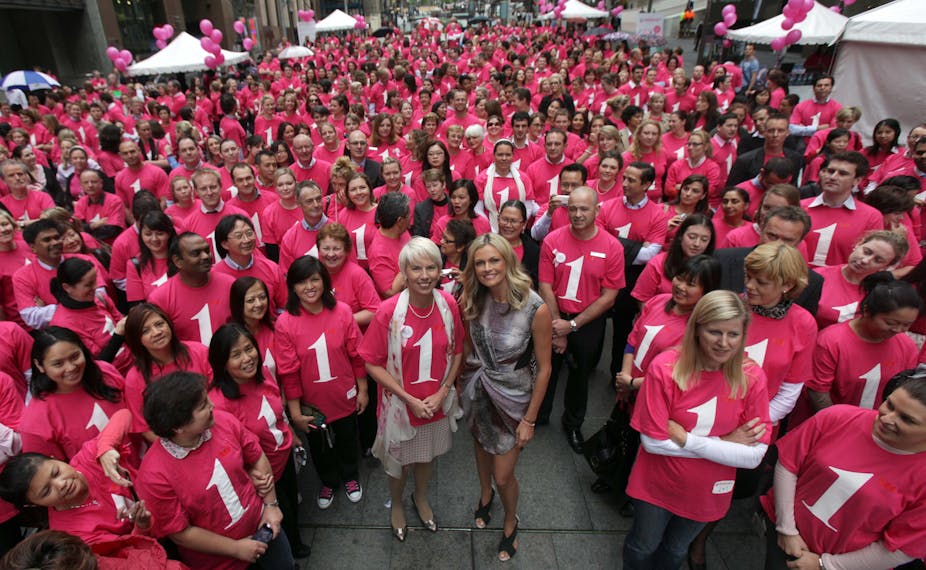Some of the most serious forms of cancer are less likely to be the subject of a clinical trial than cancers with a less significant health impact.
Research shows that even being a disease is a popularity contest, with “sexy” afflictions like breast cancer attracting the lion’s share of research interest while less attractive illnesses such as lung cancer are comparatively neglected.
Lung cancer is responsible for the greatest burden of disease among cancers yet only 7% of trials focussed on it. Other under-represented cancers include colorectal, prostate and pancreatic cancer.
The analysis used data from two trial registries: the Australian New Zealand Clinical Trials Registry (ANZCTR) and the US site ClinicalTrials.gov, which together cover approximately 98% of registered cancer trials in Australia.
We measured burden of disease using the “disability adjusted life years” (DALY) standard. DALY is a good measure of the quantity as well as quality of life lost due to cancer.
It looks at the number of years of life lost due to early death from cancer plus healthy years lost due to living with cancer.
Our findings are consistent with another recent report comparing the number of trials with cancer incidence and mortality data.
We also found that almost 80% of cancer trials were testing drug treatments, such as chemotherapy, and new targeted therapies.
Both drug and non-drug treatments are important for cancer management, so quality as well as quantity of life can be addressed.
Non-drug treatments including surgery, radiotherapy, prevention, exercise and lifestyle were relatively under researched.
Breast cancer research differed in important ways from other cancer types. Most breast cancer trials included patients with early - curable - disease rather than advanced or incurable disease. And a high proportion addressed prevention, lifestyle and exercise treatments.
A large number of the trials were funded by non-drug company sources, such as governments, charities and universities.
The breast cancer research agenda appears more balanced compared with other cancers and this may be a result of the influence of consumer advocates.
Under-researched cancer types could take the lead from breast cancer, where consumer advocacy groups and high-profile people affected by breast cancer have played key roles in raising money for research and influenced the research agenda.
Approximately two-thirds of drug trials were funded and sponsored by drug-companies even though previous studies have raised concerns that drug company-funded research may draw conclusions influenced by their priorities.
While drug company investment in clinical trials is necessary, we may have a more balanced research agenda if non-drug company investment in trials research is encouraged.
One way to address this may be the constitution of an independent body that oversees the cancer research agenda and ensures that trials conducted address gaps in our knowledge.
Using data from clinical trial registries, this body could monitor cancer clinical trial activity across the country.
Gaps could be identified by comparing the number of trials in each cancer to their burden of disease, just as we did in our study. This information could help establish priorities for cancer clinical trials.
Federal government funding for independent cooperative clinical trial groups is vital and hospitals and universities also need to be encouraged to initiate and conduct clinical trials.
Clinical trial registration and results reporting should be mandatory in Australia as they are in the United States where it is federal law. This would ensure that registries are a comprehensive source of trials information.
As a community, we have the right to know about all trials that are conducted and whether their results are positive or negative.
An independent clinical trial administrative body would help make the trials research process transparent as well as help to avoid duplication of effort.
While there are trial registries available online, which are publicly accessible, they are not always user-friendly.
We have developed a consumer-friendly cancer clinical trials website using ANZCTR and ClinicalTrials.gov to make it easier for both doctors and people affected by cancer to search for relevant trials.
This site may assist with transparency as well as playing a role in increasing patient recruitment by making it easier for potential subjects to find suitable trials.
It will benefit patients, researchers and the community.

